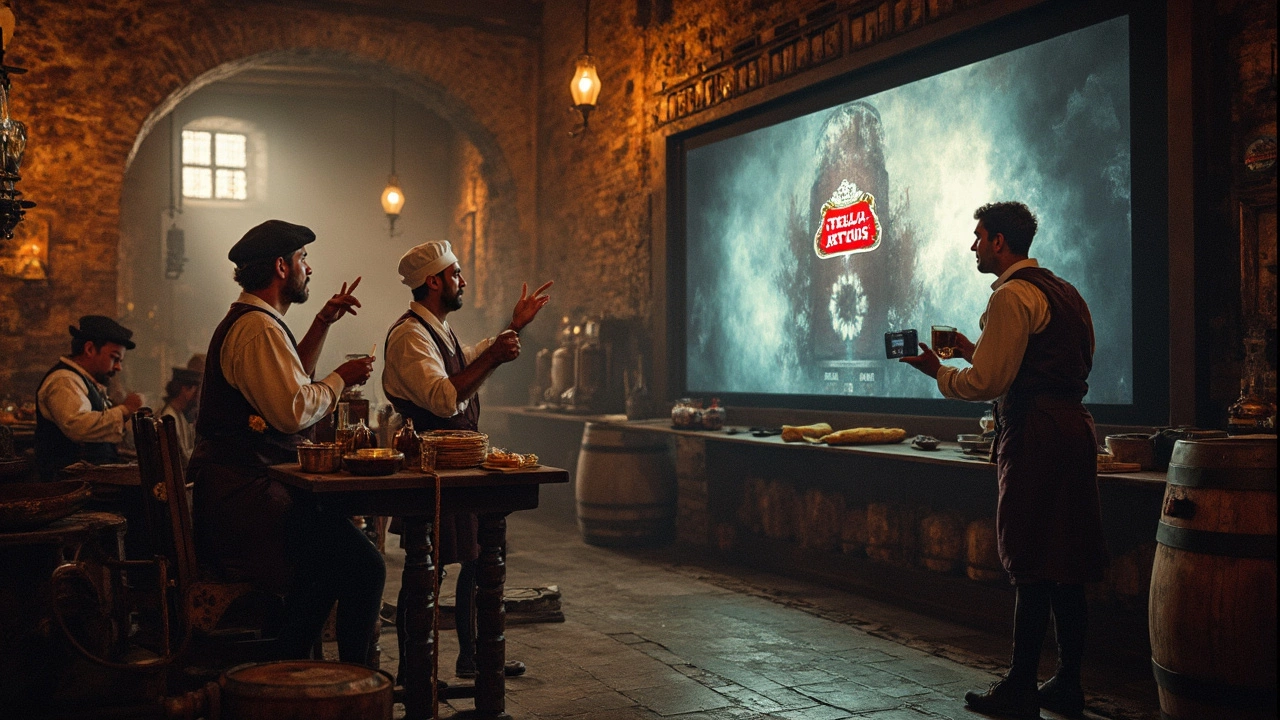So, you're at a beer festival, surrounded by an ocean of mugs and pints, when someone mentions Stella Artois. Cue the debates! This lager isn't a stranger to controversy. In festivals all over, Stella often finds itself in the crosshairs of craft brew purists and mainstream fans alike. But why?
For starters, Stella's rise to fame wasn't just luck. It has a long history dating back to 1366, but what really helped it boom globally were smart marketing tricks. Think chic packaging and those unforgettable ads positioning it as a 'premium' choice. Not everyone is buying it, though. Some beer lovers are questioning if Stella truly deserves the premium tag or if it's just clever branding doing the heavy lifting.
- The Rise of Stella Artois
- Brewing Practices Under Scrutiny
- Market Strategies That Spark Debate
- Public Perception at Beer Festivals
- Impact on Craft Breweries
- The Future of Stella Artois in Festivals
The Rise of Stella Artois
Stella Artois has roots dating back to 1366 in Leuven, Belgium, making it one of the oldest in the business. Originally brewed as a Christmas beer, its initial reputation was one of festivity and exclusivity. This made it an early hit among locals. Over time, its distinctive flavors and branding helped it transition from a seasonal specialty to a year-round favorite.
The magic with Stella Artois really took off after World War II. With Europe rebuilding, there was a thirst – quite literally – for something consistent yet sophisticated. Stella seized this opportunity, expanding beyond Belgium with a focus on Europe and eventually, the United States. The brand's knack for marketing didn't hurt either. By the 1980s, Stella positioned itself in ads as a premium lager, a notch above your average brew.
Smart branding paired with premium pricing worked wonders. People started associating Stella Artois with celebrations and a touch of class. Ever notice those elegant chalices they serve their beer in? That’s a marketing move making you feel fancy with every sip. Such strategies have pushed Stella to the top in many global markets, especially at beer festivals where it often sees new legions of fans.
Beer industry experts often point to Stella's large-scale production capabilities as a reason for its widespread availability. Unlike niche craft breweries, Stella can produce a lot of beer fast, ensuring that festival-goers around the world can enjoy an ice-cold pint, no matter where they are.
While some might argue about the authenticity behind the brew now produced in various locations worldwide, there's no denying that Stella's rise has been fueled by clever marketing combined with a rich history that continues to pull in new fans, making it a staple at beer festivals worldwide.
Brewing Practices Under Scrutiny
The way Stella Artois brews its beer has sparked plenty of gab around barrels and kegs, especially among the purists. Some folks are raising eyebrows at the ingredients and methods used, questioning whether they match up with that premium image.
For one, the beer contains maize or corn, which some beer enthusiasts argue is a cost-cutting move that can affect flavor. Traditionalists often prefer barley malt without these cheaper adjuncts. But let's be real—this isn't necessarily a bad thing for everyone. Some drinkers actually enjoy the lighter taste that crops up from using corn.
Then, there's the matter of alcohol content. Once upon a time, Stella was known for packing a punch with a higher ABV (alcohol by volume) in some regions, leading to its cheeky nickname 'wife beater' in the UK—a nod to potential overconsumption. In recent years, however, it's been adjusted to more moderate levels, seemingly to appeal to a broader audience.
Another sticking point? The brewing process itself. Critics often bring up the automated mass production methods, claiming they lose some of the passion and artistry you'd find in craft beer brewing. You know, the stuff that makes small-batch beers so intriguing.
While some argue these practices dilute the beer's quality, Stella Artois fans assert it's all about consistency and efficiency, aiming for that reliable taste no matter where you pop a bottle top. And with sales numbers speaking for themselves, it seems that strategy is working for quite a number of people.
| Aspect | Criticism |
|---|---|
| Ingredients | Use of maize affects traditional flavor |
| Alcohol Content | Reduction for wider appeal |
| Brewing Method | Mass production vs. craft artistry |
Market Strategies That Spark Debate
Dive into the hows and whys of Stella Artois making waves in the beer world, and you'll find some strategic moves that push buttons. One big point of contention is its clever branding. Promoted as a 'premium' beer, Stella's image is polished and stylish, appealing to those who want to feel fancy without spending a fortune. Given its massive distribution network, Stella is everywhere—from pubs to the fanciest of restaurants—challenging smaller craft brewers when it comes to shelf space and taps.
This kind of widespread availability might seem like a win for beer lovers, but it comes at a cost. Critics argue that with its global reach, Stella often overshadows local brewers at beer festivals, sometimes seeming less like a special guest and more like an uninvited party crasher. However, fans of Stella see this as a testament to its global appeal and consistent quality.
Another hot topic is Stella’s pricing strategy. It's usually priced higher than many other lagers, leveraging its so-called 'premium' branding. This pricing model both intrigues and frustrates consumers—some pay happily, buying into the high-end promise, while others roll their eyes, considering it a marketing gimmick.
Stella’s advertising campaigns also spark both admiration and annoyance. With memorable taglines and a consistent brand image that reinforces its premium position, Stella doesn’t just sell beer; it sells an experience. But not everyone is on board with this approach. Some say the heavy marketing feels more like smoke and mirrors rather than an authentic beer experience.
Check out this quick comparison that shows how Stella's pricing compares to local craft options:
| Beer Brand | Average Price Per Pint (AUD) |
|---|---|
| Stella Artois | 10.00 |
| Local Craft | 8.50 |
With these tactics, Stella Artois consistently finds itself at the center of lively discussions, especially among devotees of smaller and local brews. The ongoing debate is whether these strategies are a celebration of smart business or a savvy way of overmarketing a product. Whatever the case, it keeps Stella Artois in the limelight, and that’s exactly where it likes to be.

Public Perception at Beer Festivals
When it comes to Stella Artois at beer festivals, opinions seem to be as varied as the brews on tap. Walking through the festival grounds, you're likely to hear folks divided into two camps. There's the crowd that sees Stella as a classic European choice, a fancy alternative to the basic lagers that have dominated for years. To them, the branding as 'Leuven's finest' gives it a certain prestige.
On the flip side, there's a growing number of festival-goers who dismiss Stella as a sell-out. They argue that it doesn't offer the craftsmanship or the unique flavor profiles people are looking for in a festival setting. It's often compared to other mainstream giants rather than celebrated craft breweries, which some beer enthusiasts believe takes away from the rich tapestry of brews that festivals aim to showcase.
Interestingly, a survey conducted at the Sydney Beer and Brewer Festival last year found that while nearly 60% of attendees had tried Stella Artois, only about 35% rated it as their first choice. That's a decent chunk, but it shows a preference for smaller, local brews among festival regulars.
There's also the big question of authenticity. With Stella Artois now produced under the umbrella of AB InBev, the beer behemoth, some festival participants feel it has lost some of its heritage and uniqueness—a big deal for those who take their beers seriously.
Despite all this, Stella's still pouring by the pint at these events. Its presence at festivals isn't waning. For some, it's a comforting go-to; for others, it's the beer they love to debate about over a foam-filled night.
Impact on Craft Breweries
The presence of Stella Artois in the beer scene, especially at beer festivals, often stirs mixed emotions among craft brewers. Some see it as an odd mix of David and Goliath, where the big-name Stella seems to cast a long shadow over smaller, passionate craft breweries.
Here's the deal: craft breweries pride themselves on unique flavors, diverse ingredients, and small-batch quality. On the flip side, Stella has the muscle of big production and distribution networks. This means at large festivals, where space and taps are limited, Stella's inclusion might limit exposure for small-time craft brewers.
On the flip side, Stella's presence can sometimes draw in more crowds who might not have shown up otherwise. If you're a craft brewer, it's like having a big-ticket opener bring people to your gig; fans of Stella Artois might end up falling in love with your honey-infused ale once they’re in the door.
There are nationwide whispers about how the overall craft beer market is evolving. From 2019 to 2024, craft beer production grew by a steady 4% annually, according to some industry stats. But, every time a high-profile brand like Stella steps into a local event, it nudges the competition and market dynamics, making waves in how festivals curate their lineups.
And let's not forget about the branding leverage. While craft breweries pour creativity into quirky, eye-catching labels and regional stories, Stella’s established branding might eclipse these efforts, even though everyone's got a fair shot in the vast beer galaxy.
The Future of Stella Artois in Festivals
Looking ahead, the journey of Stella Artois at beer festivals seems like it's set to be an interesting one. With its well-known history and sophisticated marketing, Stella isn't just resting on its laurels. They're actively trying to keep up with beer trends and consumer demands, which is crucial in maintaining its place at the top, especially in bustling festivals where new flavors are constantly vying for attention.
One of the key strategies Stella is banking on is embracing sustainability. People today are more eco-conscious, and having a sustainable brewing process could boost its popularity among younger festival-goers. Imagine an ice-cold Stella that's not just refreshing but also eco-friendly—that's a potential win-win!
Moreover, festivals love to celebrate innovation, so Stella experimenting with limited edition brews could spice things up. Imagine a special Stella-only event within the festival where they showcase these unique brews. That not only draws attention to the brand but also gives festival-goers something new to talk about.
Keep in mind, the craft beer scene is exploding, and it’s not going anywhere. Stella needs to continue finding ways to coexist with smaller breweries at these events. A potential collaboration with local brewers might be a clever way to blend heritage with innovation and maintain relevance in a competitive environment.
If they pull it off, there's a good chance you'll see many more Stella Artois logos shining bright across festival grounds. Facing competition head-on while adapting to current trends might just keep this iconic beer as a steady staple at beer festivals worldwide.


